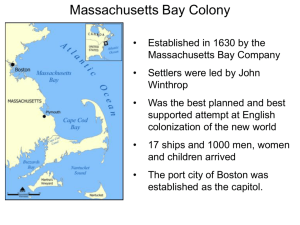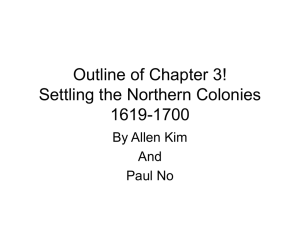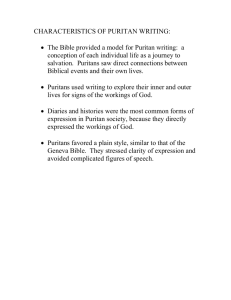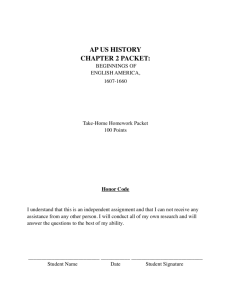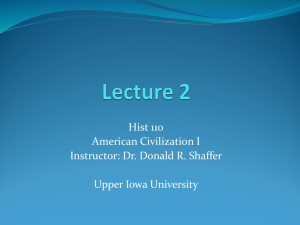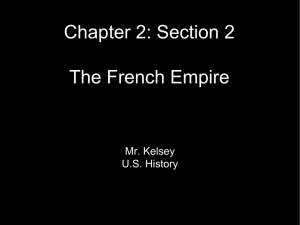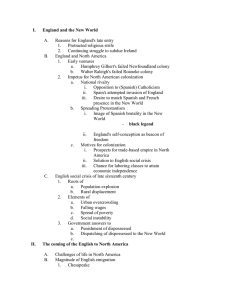Chapter 2: The Invasion and Settlement of North America, 1550–1770
advertisement
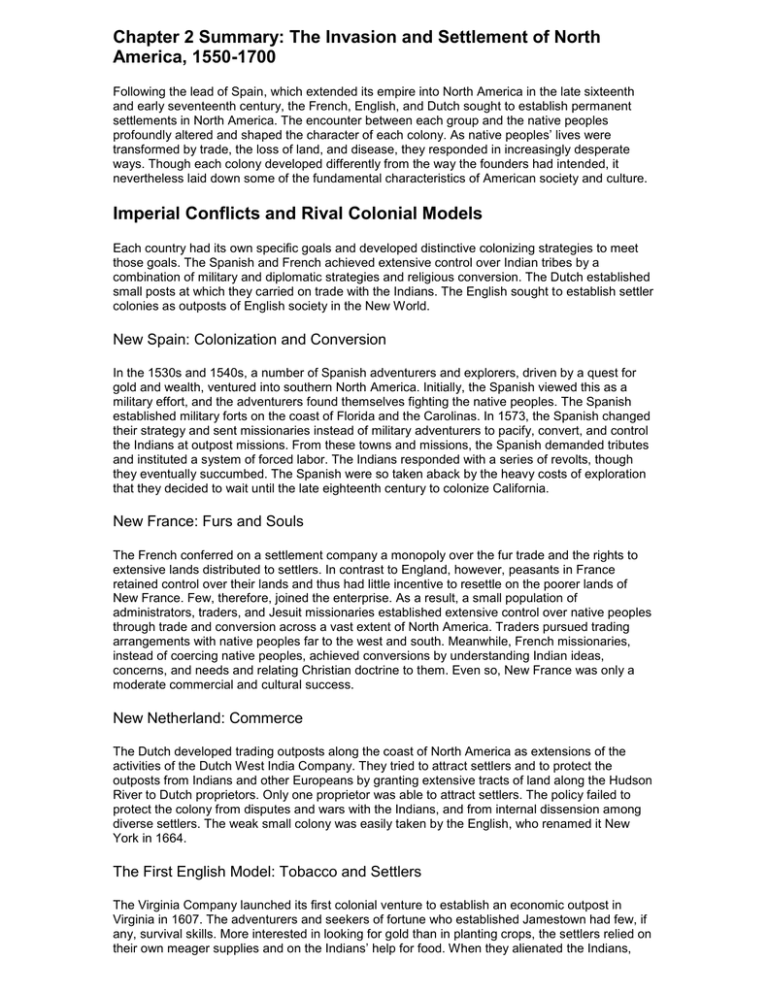
Chapter 2 Summary: The Invasion and Settlement of North America, 1550-1700 Following the lead of Spain, which extended its empire into North America in the late sixteenth and early seventeenth century, the French, English, and Dutch sought to establish permanent settlements in North America. The encounter between each group and the native peoples profoundly altered and shaped the character of each colony. As native peoples’ lives were transformed by trade, the loss of land, and disease, they responded in increasingly desperate ways. Though each colony developed differently from the way the founders had intended, it nevertheless laid down some of the fundamental characteristics of American society and culture. Imperial Conflicts and Rival Colonial Models Each country had its own specific goals and developed distinctive colonizing strategies to meet those goals. The Spanish and French achieved extensive control over Indian tribes by a combination of military and diplomatic strategies and religious conversion. The Dutch established small posts at which they carried on trade with the Indians. The English sought to establish settler colonies as outposts of English society in the New World. New Spain: Colonization and Conversion In the 1530s and 1540s, a number of Spanish adventurers and explorers, driven by a quest for gold and wealth, ventured into southern North America. Initially, the Spanish viewed this as a military effort, and the adventurers found themselves fighting the native peoples. The Spanish established military forts on the coast of Florida and the Carolinas. In 1573, the Spanish changed their strategy and sent missionaries instead of military adventurers to pacify, convert, and control the Indians at outpost missions. From these towns and missions, the Spanish demanded tributes and instituted a system of forced labor. The Indians responded with a series of revolts, though they eventually succumbed. The Spanish were so taken aback by the heavy costs of exploration that they decided to wait until the late eighteenth century to colonize California. New France: Furs and Souls The French conferred on a settlement company a monopoly over the fur trade and the rights to extensive lands distributed to settlers. In contrast to England, however, peasants in France retained control over their lands and thus had little incentive to resettle on the poorer lands of New France. Few, therefore, joined the enterprise. As a result, a small population of administrators, traders, and Jesuit missionaries established extensive control over native peoples through trade and conversion across a vast extent of North America. Traders pursued trading arrangements with native peoples far to the west and south. Meanwhile, French missionaries, instead of coercing native peoples, achieved conversions by understanding Indian ideas, concerns, and needs and relating Christian doctrine to them. Even so, New France was only a moderate commercial and cultural success. New Netherland: Commerce The Dutch developed trading outposts along the coast of North America as extensions of the activities of the Dutch West India Company. They tried to attract settlers and to protect the outposts from Indians and other Europeans by granting extensive tracts of land along the Hudson River to Dutch proprietors. Only one proprietor was able to attract settlers. The policy failed to protect the colony from disputes and wars with the Indians, and from internal dissension among diverse settlers. The weak small colony was easily taken by the English, who renamed it New York in 1664. The First English Model: Tobacco and Settlers The Virginia Company launched its first colonial venture to establish an economic outpost in Virginia in 1607. The adventurers and seekers of fortune who established Jamestown had few, if any, survival skills. More interested in looking for gold than in planting crops, the settlers relied on their own meager supplies and on the Indians’ help for food. When they alienated the Indians, their food supply was cut off and most of the settlers perished over the winter. The efforts of subsequent leaders to impose discipline enabled the colony to survive from one year to the next, but just barely. Within ten years, the Virginia Company, to draw settlers to the colony, had instituted the headright system, developed tobacco as a cash crop, and established local government. The strategy worked, but as settlers spread farther across the wilderness, Indian resistance increased. An Indian uprising in 1622 inflicted heavy casualties on the colony. Distressed by its poor performance, King James assumed control over Virginia and, by instituting local government under royal control, established the model for royal colonies throughout North America. The Chesapeake Experience The Chesapeake colonies brought wealth to planters and religious freedom to Catholics in Maryland, but European settlement destroyed native American communities and subjected both European indentured servants and African slaves to ruthless exploitation for the sake of profit. Settling the Tobacco Colonies The Chesapeake colonies made money, but at a considerable moral and social cost. While Virginia became a royal colony, a royal charter made Lord Baltimore, a Catholic, proprietor of Maryland. Baltimore carefully planned the development of the small colony both as a refuge for Catholics and as a cash-crop colony. The tobacco boom assured its continued economic growth, but friction between Protestants and Catholics persisted. In both colonies, epidemic disease resulted in an extraordinarily high death rate among colonists. The high death rate disrupted families, shifted gender roles, and eroded social institutions. Servants and Masters The headright system and a large demand for labor attracted many indentured servants to the Chesapeake colonies. Laborers were bound to a master for several years and compelled to work in often brutal conditions. They were not allowed to marry and were punished harshly for various infractions against a stringent legal code. While half the men died before they were freed, women—being generally in short supply in the Chesapeake—could achieve social mobility by marrying a landlord and sometimes even their master. The Seeds of Revolt A collapse in the price of tobacco by 1660 increased social friction throughout the Chesapeake colonies. Lower prices forced many planters deeper into debt even as they grabbed the last available lands in the colonies. Low prices all but eliminated the prospect that a newly freed servant could become a planter. More and more former servants were forced to lease lands from planters as tenant farmers or farm laborers or head west to the frontier in search of cheap land. Government officials exacerbated the tensions by granting more lands to a privileged elite and trying to exclude landless freemen, who by the 1670s constituted half the population, from voting. This effort to translate the widening distance between classes into a political oligarchy sowed the seeds of revolt. Bacon’s Rebellion As settlers in the western part of the colony, increasingly resentful of the social and political exploitation in the colony, pushed on to the last Indian lands left in Virginia, the pressure boiled over. When westerners led by newcomer Nathaniel Bacon, a member of the governor’s council, started a war against the Indians, the governor condemned them, expelled Bacon from the council, and ordered his arrest. Bacon, however, forced the governor to back down and institute reforms. Still not satisfied, Bacon rebelled openly and civil war broke out, only to end when Bacon died suddenly. To prevent further rebellions, the elite, after punishing the rebels, returned voting rights to the lower class, reduced taxes, and instituted an expansionist land policy. They also looked for ways to acquire more control over a labor force that was needed to grow tobacco. Puritan New England In contrast to Virginia, New England was settled by dissenters seeking religious freedom. New England Puritans arrived as families and established small villages of yeomen farmers centered around their churches and governed by a strict ethical code. The Puritan Migration The first wave of migrants to New England traveled as a joint-stock company and established the Plymouth colony in 1620. Only half survived the first winter, but community discipline thereafter helped the colony to thrive and grow. Named Pilgrims because they had come to America as a holy pilgrimage, the residents of Plymouth nevertheless maintained a separation of church and state authority. As King Charles I increasingly oppressed Puritans in England, a second wave of migants under John Winthrop left for America to establish a pure, model Christian community. They settled Massachusetts Bay colony, near Plymouth, but, unlike the Puritans, firmly linked the powers of church and state, becoming a religious commonwealth. Religion and Society, 1630–1670 The Puritans gave the process of settlement and subsequent American history a moral dimension. They sought not only worldly wealth and security but also a place in which they could establish a purified "true" church as a model for the reformation of the Anglican Church. Church membership was limited to those "saints" who were able to demonstrate that they had had a conversion experience and thus might be among the elect. Sometimes members joined together in a collective covenant with God. They were also given influence over secular affairs, transforming Massachusetts Bay into a theocracy. Always a minority of the population, church members ran self-governing congregations. By accepting new membership applications, appointing, screening, and firing ministers, scrutinizing members, and purging heresies and expelling heretics, the elect exerted considerable moral, political, and social power. The Puritan Imagination and Witchcraft Like other European peasants imbued with the pagan tradition that still underlay the Christian cosmos, as well as that of the native Americans, the Puritans believed that nature contained spiritual forces. They also believed that both God and evil spirits expressed their will or power through natural signs, miracles, invisible "grace," or negative forces often relayed by wizards or witches. The Puritans’ doubts about their original mission and a variety of pressures in the congregations and villages increased their tendency to explain events as the result of evil forces. Not surprisingly, arrests and convictions for witchcraft increased, culminating in a dramatic outbreak of witch-hunting in 1692. In Salem, frustrated farmers resentful of wealthier church members retaliated by accusing scores of their neighbors and friends of witchcraft. Of the 175 people arrested, 20 were executed before proceedings were stopped because of unsubstantiated evidence. A Yeoman Society, 1670–1700 The Puritans believed that some inequality of wealth was part of the natural order of things. Nevertheless, most townsmen received sufficiently significant tracts in fee simple to establish themselves as yeomen farmers. This relatively equal distribution of land enabled most men to become involved in local politics and gave them unprecedented political power. Even though the dynamics of market competition would further differentiate wealth and push many farmers into tenancy, most settlers in New England achieved a better life than they had had in England. The Indians’ New World Native Americans responded to the arrival and expansion of the settlement of European "invaders" by resisting, trying to cope, or immigrating to the West. Whatever their response, however, the Indians found their world fundamentally changed. Puritans and Pequots Though one might have expected otherwise, the moralist Puritans, convinced that God was on their side, often treated the Indians as brutally as the Spanish had. When the Indians violently resisted, the Puritans retaliated with brutal attacks. Indians who chose not to resist allowed themselves to be converted in "praying towns." Attempts at conversion provided Puritans with a buffer against further Indian attacks, and Indians with a temporary haven. Metacom’s War Metacom, the leader of the Wampanoag tribe, believed conversion was not the answer. He forged an alliance of smaller tribes and attacked white settlements across central New England in 1675 and 1676. In retaliation, the Puritans attacked the Indians. They inflicted massive casualties and sold hundreds of captives into slavery. The surviving Indians resigned themselves to losing both their land and their culture. The Fur Trade and the Inland Peoples Farther inland, the fur trade transformed Indian life. European traders brought disease, alcohol, and European trade goods. These conditions reduced populations, increased social disorder, and undermined native cultures. The dynamics of the fur trade also intensified intra-tribal warfare, shifted power to younger, more aggressive warriors, and fundamentally transformed the Indians’ spiritual relationship with nature. In the end, the Indians, as much as the Europeans, lived in a New World. Chapter 2: The Invasion and Settlement of North America, 1550–1770 Chapter Instructional Objectives After you have taught this chapter, your students should be able to answer the following questions: 1. What goals did the Spanish, French, Dutch, and English pursue in North America? How did these ambitions lead to different settlement patterns? 2. How did the European settlements of North America affect Native American populations? 3. How and why did a system of forced labor emerge in the Chesapeake and Virginia colonies? 4. What were the economic, religious, political, and intellectual foundations of Puritan society in New England? 5. How did colonial society in the Chesapeake region differ from that of New England? 6. How did the conflicts of the 1670s affect relations among colonists, Indians, and Africans in America? Chapter 2: Invasion and Settlement (1550-1770) I. Imperial Conflicts and Rival Colonial Models A. New Spain: Colonization and Conversion 1. Spanish adventurers were the first Europeans to explore the southern and western United States. 2. By the 1560s their main goal was to prevent other Europeans from establishing settlements. 3. In 1565, Spain established St. Augustine, the first permanent European settlement in America; most of Spain’s other military outposts were destroyed by Indian attacks. 4. In response to the Indian attacks, the Spanish adopted The Comprehensive Orders for New Discoveries (1573) and employed missionaries. 5. For Franciscans, religious conversion and assimilation went hand in hand, but Spanish rule was not benevolent. 6. Most Native Americans tolerated the Franciscans, but when Christian prayers failed to prevent disease, drought, and Apache raids, many returned to their ancestral religions and blamed the Spanish for their ills. 7. Santa Fe was established in 1610, and after the Indian revolts, the system of missions and forced labor was reestablished. 8. By 1680 many Pueblos in New Mexico were faced with extinction; the Pueblos eventually joined with the Spanish to protect their lands against nomadic Indians. 9. Spain maintained its northern empire but did not achieve religious conversion or cultural assimilation of the Native Americans. 10. The cost of expansion delayed the Spanish settlement of Ca. B. New France: Furs and Souls 1. Quebec, established in 1608, was the first permanent French settlement; New France became a vast fur-trading enterprise. 2. The Hurons, in exchange for protection from the Iroquois, allowed French traders into their territory. 3. French traders set in motion a series of devastating Indian wars over the fur market, and they also brought disease to the Indians. 4. Beginning in the 1640s, the New York Iroquois seized control of the fur trade and forced the Hurons to migrate to the north and west. 5. While French traders amassed furs, French priests sought converts; unlike the Spanish, French missionaries did not use Indians for forced labor, and they won religious converts by addressing the needs of the Indians. C. New Netherland: Commerce 1. The Dutch republic emphasized commerce over religious conversion. 2. In 1621 the West India Company had a trade monopoly in West Africa and exclusive authority to establish outposts in America. 3. The company founded the town of New Amsterdam as the capital of New Netherland. 4. To encourage migration, the company granted land along the Hudson River to wealthy Dutchmen. 5. New Netherland failed as a settler colony but flourished briefly in fur trading. 6. When the Dutch seized prime farming land from the Algonquians and took over their trading network, the Algonquians responded with force. 7. The West India Company largely ignored the floundering Dutch settlement and concentrated instead on the profitable importation of African slaves to their sugar plantations in Brazil. 8. The Dutch ruled New Amsterdam shortsightedly, rejecting requests for representative government, and after a lightly resisted 1664 English invasion, New Amsterdam happily accepted English rule. D. The First English Model: Tobacco and Settlers 1. English merchants replaced the landed gentry as the leaders of English expansion. 2. In 1606, King James I granted a group of London merchants the right to exploit from present-day North Carolina to southern New York; this region was named Virginia. 3. In 1607 the Virginia Company sent an expedition of men to North America, landing in Jamestown,Virginia; the goal of the Virginia Company was trade, not settlement. 4. Life in Jamestown was harsh: death rates were high, there was no gold and little food. 5. Native American hostility was another major threat to the survival of the settlement; as conflicts over food and land increased, Chief Powhatan threatened war with the settlers. 6. Tobacco farming became the basis of economic life and an impetus for permanent settlement in Jamestown. 7. To encourage English settlement, the Virginia Company granted land to freemen, established a headright system and a local court system, and approved a system of representative government under the House of Burgesses. 8. The resulting influx of settlers sparked war with the Indians but did not slow expansion; by 1630, English settlement in the Chesapeake Bay was well established. II. The Chesapeake Experience A. Settling the Tobacco Colonies 1. In 1622, James I dissolved the Virginia Company and created a royal colony in Virginia in 1624. 2. The Church of England was established in Virginia, and property owners paid taxes to support the clergy. 3. The model for royal colonies in America consisted of a royal governor, an elected assembly, and an established Anglican Church. 4. King Charles I conveyed most of the territory bordering the Chesapeake to Lord Baltimore, a Catholic aristocrat. 5. Baltimore wanted Maryland to become a refuge from persecution for English Catholics; settlement of Maryland began in 1634. 6. Baltimore granted the assembly the right to initiate legislation. 7. A Toleration Act was enacted in 1649, granting religious freedom to all Christians. 8. Demand for tobacco started an economic boom in the Chesapeake and attracted migrants, but diseases, especially malaria, kept population low and life expectancy short. B. Masters, Servants, and Slaves 1. The majority of migrants to Virginia and Maryland were indentured servants; most masters ruled with beatings and withheld permission to marry. 2. Most indentured servants did not achieve the escape from poverty they had sought, although about 25 percent benefited from their ordeal, acquiring property and respectability. 3. The first African workers fared even worse than the indentured servants, and their numbers remained small. 4. At first, Africans were not legally enslaved, although many served their masters for life. 5. By becoming a Christian and a planter, an enterprising African could sometimes aspire to near equality with English settlers. 6. In the 1660s, Chesapeake legislatures began enacting laws that lowered the status of Africans; being a slave had become a permanent and hereditary condition. C. The Seeds of Social Revolt 1. By the 1660s the Chesapeake tobacco market had collapsed and long-standing conflicts between rich planters and men with small farms or no property flared up in political turmoil. 2. In an effort to exclude Dutch and other merchants, Parliament passed an Act of Trade and Navigation (1651), permitting only English or colonial-owned ships into American ports. 3. The number of tobacco planters increased, but profit margins were growing thin; the Chesapeake ceased to offer upward social mobility to whites as well as blacks. 4. The Chesapeake colonies came to be dominated by elite planterlandlords and merchants. 5. Social tensions reached a breaking point in Virginia during Governor William Berkeley’s regime; Berkeley gave tax-free land grants to himself and members of his council. 6. The corrupt House of Burgesses changed the voting system to exclude landless freemen, but distressed property-holding yeomen were no longer willing to support the rule of the corrupt landed gentry. D. Bacon’s Rebellion 1. Poor freeholders and aspiring tenants wanted the Indians removed from the treaty guaranteed lands along the frontier. 2. Wealthy planter-merchants were opposed to Indian removal; they wanted to maintain the labor supply and to continue trading furs with the Native Americans. 3. Poor freeholders and propertyless men formed militia and began killing Indians; the Indians retaliated by killing whites. 4. Not wanting the fur trade disrupted, Governor Berkeley proposed building frontier forts. 5. Settlers saw Berkeley’s strategy as a plot to impose high taxes and to take control of the tobacco trade. 6. Nathaniel Bacon, a member of the governor’s council, led a protest against Berkeley’s strategy; Bacon and his men killed a number of peaceful Indians for which Berkeley arrested Bacon. 7. When Bacon’s militant supporters threatened to free Bacon by force, Berkeley agreed to political reforms and restored voting rights to landless freemen. 8. Not satisfied, Bacon’s men burned Jamestown and issued a “Manifesto and Declaration of the People,” demanding removal of all Indians and an end to the rule of wealthy “parasites.” 9. Although Bacon died in 1676, Bacon’s Rebellion prompted tax cuts, a reduction of corruption, opening of public offices to yeomen, and the expansion into Indian lands. 10. To forestall another rebellion among former indentured servants,Virginia and Maryland turned away from indentured servitude, and laws were enacted to legalize African slavery. III. Puritan New England A. The Puritan Migration 1. New England differed from other European settlements; it was settled by men, women, and children. 2. The Pilgrims, who were “Separatists” from England’s Anglican Church, sailed to America in 1620 on the Mayflower. 3. They created the Mayflower Compact, a covenant for religious and political autonomy and the first constitution in North America. 4. The first winter in America tested the Pilgrims as hunger and disease took a heavy toll; thereafter, the Plymouth colony became a healthy and thriving community. 5. After having Anglican rituals forced upon their churches, Puritans sought refuge in America; in 1630, John Winthrop and 900 Puritans established the Massachusetts Bay colony. 6. Over the next decade, 10,000 Puritans migrated to Massachusetts Bay along with 10,000 others fleeing hard times in England. (more went to Barbados than to New England) 7. The Puritans created representative political institutions that were locally based. 8. The right to vote and hold office was limited to Puritan church members, and the Bible was the legal as well as spiritual guide for Massachusetts Bay. B. Religion and Society, 1630–1670 1. Puritans eliminated bishops and devised a democratic church structure; influenced by John Calvin, they believed in predestination. 2. Puritans dealt with the uncertainties of divine election in three ways: “conversion experience,” a born-again conviction of salvation; “preparation,” confidence in redemption built on years of piety and discipline; and belief in a “covenant”with God that promised salvation in exchange for obedience to God’s laws. 3. Puritans of Massachusetts Bay felt that they must purge their society of religious dissidents. 4. Roger Williams, a religious dissident, and his followers founded settlements in Rhode Island, where there was no legally established church. 5. Anne Hutchinson was considered a heretic because her beliefs diminished the role of Puritan ministers; Puritans believed that when it came to governance of church and state, women were clearly inferior to men. 6. In 1636, Thomas Hooker and others left Massachusetts Bay and founded Hartford; in 1639, the Connecticut Puritans adopted the Fundamental Orders, which provided for a representative assembly and a popularly elected governor. 7. Connecticut’s government also included a representative assembly and elected governor; Connecticut united church and state, but voting was not limited to church members. 8. England fell into a religious civil war between royalists and Parliamentary forces, and thousands of English Puritans joined the revolt, demanding greater authority for Parliament and reform of the established church. 9. After four years of civil war, Parliamentary forces led by Oliver Cromwell were victorious, but the Puritan triumph was short lived. 10. With the failure of the English Revolution, Puritans looked to create a permanent society in America based on their faith and ideals. C. The Puritan Imagination and Witchcraft 1. Puritans thought that the physical world was full of supernatural forces; their respect for spiritual forces perpetuated certain pagan superstitions shared by nearly everyone. 2. Between 1647 and 1662, Puritan civil authorities in Massachusetts and Connecticut hanged fourteen people for witchcraft. 3. In 1692 in Salem,Massachusetts, 175 people were arrested and 20 were hanged for witchcraft. 4. Popular revulsion against the executions dealt a blow to the dominance of religion in public life; there were no more legal prosecutions for witchcraft after 1692. 5. The European Enlightenment helped promote a more rational view of the world. D. A Yeoman Society, 1630–1700 1. Puritans instituted a fee simple land distribution policy that encouraged the development of self-governing communities. All landowners had a voice in the town meeting. Consequently, ordinary New England farmers enjoyed far more political power than their European or Chesapeake counterparts. 2. Puritans believed in a social and economical hierarchy: the largest plots of land were given to men of high social status. 3. As all male heads of families received some land, a society of independent yeomen farmers emerged. 4. Town meetings chose selectmen, levied taxes, and enacted ordinances and regulations; as the number of towns increased, so did their power, enhancing local control. 5. As one generation gave way to the next, the farming communities of New England became more socially divided, yet nearly all New Englanders had an opportunity to acquire property. IV. The Indians’New World A. Puritans and Pequots 1. Seeing themselves as God’s chosen people, Puritans tried to justify taking Indian lands on religious grounds. 2. In 1636, Pequot warriors attacked English farmers who had intruded on their lands. 3. Puritan militiamen and their Indian allies massacred about 500 Pequots, and many of the Pequot survivors were sold into slavery. 4. English Puritans viewed the Indians as “savages” who did not deserve civilized treatment. 5. Disease, military force, and Christianization eventually subdued the Indians of New England. 6. By 1670, New England settlers were, at least temporarily, guaranteed safety. B. Metacom’s Rebellion 1. By the 1670s, whites in New England numbered 55,000, while Indians numbered 16,000. 2. Seeking to stop the European advance, the Wampanoag leader Metacom forged an alliance with the Narragansett and Nipmuck peoples in 1675. 3. The group attacked white settlements throughout New England, and the fighting continued until Metacom’s death in 1676. 4. Losses were high on both sides, but the Indians losses were worse: 25 percent of the Indians’ already diminished population died from war or disease. 5. Many survivors were sold into slavery in the Caribbean, including Metacom’s family. 6. The defeated Algonquian peoples lost their land as well as the integrity of their traditional cultures. C. The Fur Trade and the Inland Peoples 1. The greatest threat to Indian cultures came from wars and epidemics brought by the fur trade. Nonetheless, the Iroquois fought to gain control of the fur trade with the French and Dutch. 2. The Iroquois waged a series of successful wars against other tribes, and these triumphs gave the Iroquois control of the fur trade with the French and the Dutch. 3. The Iroquois adopted non-Iroquois captives from these victories in order to replenish the Iroquois populations that had been diminished by epidemics and wartime losses. 4. Cultural diversity within Iroquois further increased as the Five Nations made peace with the French and allowed a number of Jesuit missionaries to live among them. 5. In 1680 the Iroquois repudiated their peace treaty with the French and again had to battle for control of the fur trade. 6. Disease, sickness from liquor, and neglected artisan skills were the fur trade’s legacy. 7. Constant warfare shifted tribal power from cautious Indian elders to headstrong young warriors. 8. The fur trade profoundly altered the natural environment by severely depleting the animal population.
